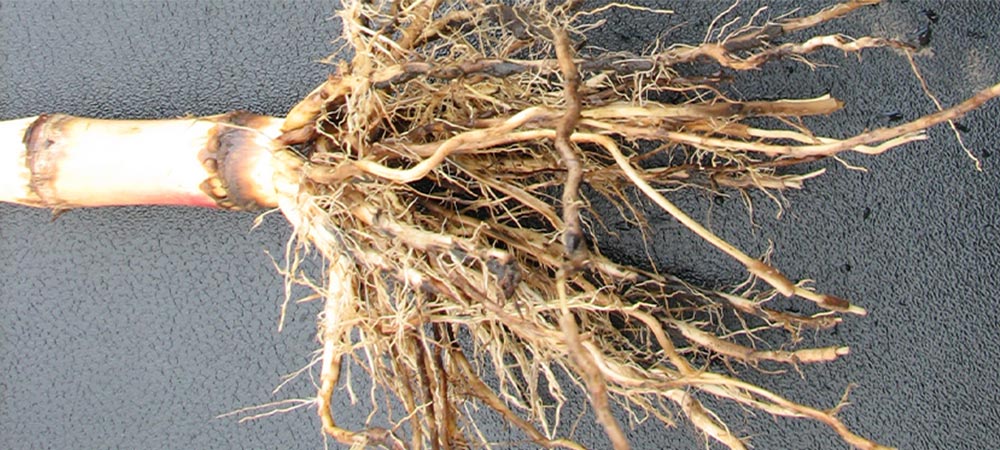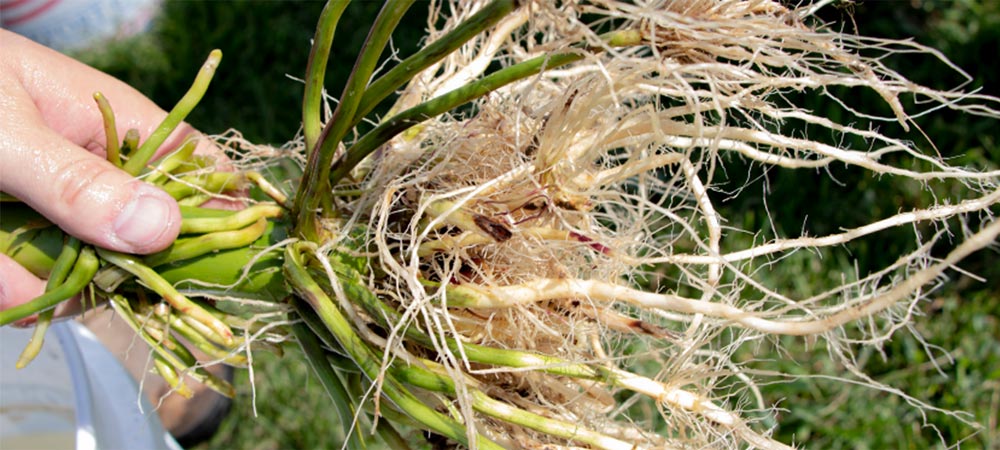Corn rootworm is a threat to corn crops all over the Midwest with the potential to damage corn at both the larval and adult stage. Larvae hatch in early summer to midsummer and feed on corn roots. Adult corn rootworm beetles can readily move between fields planted, causing damage in areas other than where they emerged. The most effective management techniques for this pest include scouting, utilizing pyramided Bt traits for control and avoiding production practices that promote corn rootworm development.
Identification and Scouting
What It Looks Like

Scouting Solutions
Scouting for corn rootworm is an effective way to learn about the current pressure in your planted fields. While rootworm pressure may vary year after year, scouting is a primary source of information used to formulate an effective control strategy for the following season. When scouting corn rootworm, prioritize fields without soil-applied insecticides or Bt corn rootworm protection, planted corn on corn and fields that had a high concentration of adult corn rootworms the previous season. Unfortunately, this pest can damage corn at both the larvae and adult stages of its life. Follow these sampling tips to help you gauge threats at both stages:

Larvae (late May-late June)
- Divide your survey field into 10 equal parts
- Randomly select one plant from each part
- Cut a 7-inch square of soil around the base of the plant using a shovel
- Carefully lift the plant out of the ground and place on a piece of plastic
- Gently break the soil away from the roots, keeping an eye out for larvae
- Alternatively, you can wash the soil and roots in a bucket — the larvae will float to the top
- Record the number of larvae and divide by the number of plants examined

Adult Beetles (late June-late August)
To determine if adult sampling is necessary in a particular field, quickly walk through the field once silking has started or will soon start. Look for beetles around the ear zone or on the ears. If no beetles are observed, continue to check twice weekly until the silks have been pollinated. If you do see pest activity, definite counts should be made. Consider using one the following methods:
Whole Plant Beetle Counts
- Sample in the morning or late afternoon when the beetles are most active
- Randomly select five plants in five different areas (25 plants total) of a field to check for beetles
- Record the number of beetles for each plant and divide by 25 to find the field average
- Continue scouting weekly until threshold levels are exceeded or beetle activity stops.
OR Sticky Traps
- Find a place for the trap at eye level.
- Remove leaves around the ears to keep your trap clear of obstructions.
- Open up the trap and fold it around the stalk so the yellow sticky side is exposed. Thread through a tie and secure it on the stalk at about corn ear level.
- Come back after one week to collect the trap and put a new trap up.
- Calculate the number of beetles on each trap you collect. Two or more beetles per trap per day means next year’s corn will be at risk for corn rootworm damage.

Sampling and Rating for Root Injury
- Make sure plants are at a growth stage where at least three nodes of roots are visible
- Dig 10 randomly selected plants from different parts of the field
- Leave a 7-inch cube around the root system
- Wash to remove soil and rate each plant for injury using this scale:
- 0 = no damage
- 1 = one complete node of roots is pruned to within 1.5 inches of the stalk
- 2 = two complete nodes of roots are pruned
- 3 = three nodes of roots are pruned.
- If you have a field average of 1.0 or more, your management program should be modified
Impact on Crops
Both corn rootworm larvae and adults are capable of damaging corn plants. Larvae begin by feeding on root hairs and outer tissue before burrowing into the roots, causing the roots to appear brown. This larval root pruning reduces water and nutrient uptake of the plants, and significant root lodging and yield reductions may occur as a result.
Corn rootworm beetle populations primarily feed on pollen, clipping silks during pollination and causing poorly filled ears. The western corn rootworm beetle is also known to feed on the leaves of the corn plant, but this isn’t particularly damaging unless there are unusually high numbers of the pest.
While considered only a minor threat to crops such as soybean and alfalfa, the western corn rootworm variant can lay eggs in these crops which could result in potential damage to next year’s corn roots if rotating to corn.
Life Cycle





Tracking

Both western and northern corn rootworm eggs are able to overwinter across the entire corn-growing region with fields growing continuous corn being at the greatest risk for damage. The development of larvae is driven by soil temperatures, and once enough heat has accumulated, eggs hatch and larvae begin feeding on corn roots.
Corn rootworm adult movement primarily occurs within the field but can also be between adjacent fields or nearby fields with different growth stages.
Management
Scouting and avoiding production practices that promote corn rootworm populations like continuous corn planting, late-planted corn fields and planting late-maturity hybrids are all integral parts of corn rootworm management.
Prevention

SmartStax® Technology
Products with SmartStax® Technology offer protection against corn rootworm along with high yield potential. Roots stay protected as corn grows thanks to two modes of action working against corn rootworm.
Expert Advice
Trait Answers
Still have questions about protecting your yield against corn rootworm? The experts at #TraitAnswers have the information you need to make your next insect management decision your best one yet.


